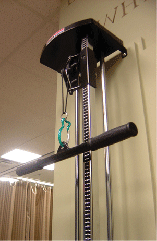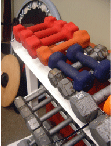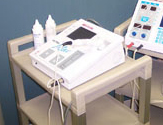of health care services.
Return to Work Programs
Independent Therapies
Massage Therapy
Physiotherapy
Chiropractic
Acupuncture / Cupping
Active Rehabilitation
Custom Orthotics
Personal Consultation
Return
To Work Rehabilitation Programs Independent
Therapies Massage
Therapy Physiotherapy Chiropractic Acupuncture/Cupping Active
Rehabilitation Custom
Orthotics Personal
Consultations Pilates L.A.S.E.R.
L.A.S.E.R.
What is “LASER”? The word "laser" stands for "light amplification by stimulated emission of radiation." Therapeutic lasers utilize a wavelength of monochromatic light in the 630 to 905 nanometer (nm) range, known as the “therapeutic window”. A wavelength of 905 nm has the least absorption in this “therapeutic window”, due to the primary influence of melanin. In the 630 to 905 nm range, the 905 nm wavelength is absorbed least by the skin and hence provides the greatest penetration of photons into the underlying tissues. It is this principle which creates the ability to “inject” photons of energy harmlessly into tissue, “energizing” or “bio stimulating” this tissue into an accelerated rate of healing.
How
does laser light heal?
Every cell in the body has light sensitive chemicals called cytochromes. These
chemicals are located in energy compartments in the cell called mitochondria. When
you stimulate cytochromes with the correct wavelength and power of
light it provides the cell with extra energy to grow, regenerate
and heal. This bio-chemical reaction increases the production of
Adenosine Triphosphate (ATP) which initiates vasodilation bring more
oxygen rich blood to injured area.
What is Laser therapy?
Laser therapy is the application of low incident levels of laser
energy to achieve an ever-increasing number of clinical indications.
These include: pain attenuation in a large variety of acute and chronic
pain entities including pain related to abnormalities in the nerves,
soft tissue, muscles, tendons, joints and bone; improved wound healing
in soft tissues, tendons and bone including the induction of healing
in slow-to-heal or non-healing wounds; improved local and systemic
blood circulation, very useful in blood-related conditions such as
Buerger’s and Raynaud’s
diseases and torpid leg ulcers; increased lymphatic circulation and
drainage which improves the early inflammation and swelling associated
with acute injuries; enhanced autoimmune response in immune-deficient
conditions such as psoriasis, rheumatoid arthritis and atopic dermatitis;
and in more specific indications such as the control of hypertension
and the restoration of normal pigment in selected abnormally coloured
cutaneous lesions.
Laser therapy is delivered using dedicated systems, designed to produce optimum levels of laser energy at specific wavelengths to achieve the desired therapeutic effect in complete safety. These systems should be compact enough to be easily portable; rugged enough to withstand extended use in and out of the treatment room; and reliable enough to preclude constant technical problems while being easily maintained.
The Benefits of Laser Therapy
- Non-Toxic
- Non-Invasive
- Easy to Apply
- No Side Effects or Pain
- Extremely Safe
- Cost Effective for Practitioner and Patient
- Highly Effective for Patient (>90% efficacy)
- Growing Acceptance of Laser Technology
- Superior Alternative to: Analgesics, NSAID’s, Other Medications, Other Modalities
- Reduces Need for Surgery
- Virtually No Contra-Indications
Therapeutic Laser Biological Effects
- Rapid Cell Growth – Laser light accelerates cellular reproduction and growth.
- Faster Wound Healing – Laser light stimulates fibroblast development and accelerates collagen synthesis in damaged tissue.
- Increased Metabolic Activity – Higher outputs of specific enzymes, greater oxygen and food particle loads for blood cells and thus greater production of the basic food source for cells, Adenosine Tri-Phosphate (ATP).
- Reduced Fibrous Tissue Formation – Laser light reduces the formation
of scar tissue following tissue damage from: cuts, scratches, burns
or post surgery.
Anti-Inflammatory Action – Laser light reduces swelling caused by bruising or inflammation of joints to give enhanced joint mobility. - Increased Vascular Activity – Laser light induces temporary vasodilation increasing blood flow to damaged areas.
- Stimulated Nerve Function – Slow recovery of nerve function in damaged
tissue can result in “dead” limbs or numb areas. Laser light
speeds the process of nerve cell reconnection to bring the numb areas
back to life. Therapeutic lasers work by supplying energy to the
body in the form of photons of light and allowing the body to effect
its own repairs. Generally speaking, the biostimulating effect of laser
therapy is in its anti-inflammatory, analgesic and anti-edematous effect
on tissues. There is absolute increase in microcirculation, higher rates
of ATP, RNA and DNA synthesis, and thus better tissue oxygenation and nutrition.
There is also an increase in the absorption of interstitial fluid,
better tissue regeneration and stimulation of the analgesic effect.
A partial list of medical conditions which have responded well to LLLT include:
Sports Injuries:
- Tennis Elbow (lateral epicondylitis)
- Golfer’s Elbow (medial epicondylitis)
- Runner’s Knee (patello-femoral syndrome)
- Jumper’s Knee (patello-tendinitis)
- Achilles Tendonitis
- Heel Cushion Pain (plantar fasciitis)
- Sprains, Strains, Tendinitis
Work Related Injuries:
- Carpal Tunnel Syndrome
- Back Pain (cervical, thoracic, lumbar, sacral, sacroiliac, bursitis, fibromyositis)
Pain Control:
- Sciatica
- Radiculopathy
- Neuralgia
Arthritis:
- Rheumatoid Arthritis
- Osteoarthritis
Wound Healing:
- Decubitis Ulcers
- Venous Stasis Ulcers
- Diabetic Foot Ulcers
Chronic Pain Management
With over 50 million people suffering from chronic pain in the US alone, it is not surprising to learn that a large number of patients are seeking alternative treatment methodologies to the overused prescription medications that are now clinically proven to have significant side-effects.
Cold laser is a non-invasive, non-toxic treatment methodology that is able to be used for numerous types of acute and chronic pain. The FDA approved Theralase® system works by delivering billions of photons to the tissue surface driving this energy down to the damaged cells that require this energy for healing. The Theralase® superpulsed laser technology is able to drive light energy up to 4” below the skin surface. Light energy of the correct wavelength(color) and power is able to dramatically increase the healing rate of damaged cells; thus allowing the body to heal itself at an accelerated rate. Pain is believed to originate from an ionic differentiation of potassium and sodium gradient across a cellular membrane. The Theralase® superpulsed technology with its 905nm near infrared technology has been clinically proven to be absorbed by the inter-lipid layer forming the cellular membrane of cells. The increase in cellular membrane permeability induced by the Theralase® laser system causes a reabsorbion of sodium and potassium molecules thus removing the gradient and hence the pain signal.
For more information on our treatments and lasers please feel free
to consult one of our laser specialists.
Anti-Inflammation
LLLT has an anti-oedemic effect as it causes vasodilation, but also
because it activates the lymphatic drainage system (drains swollen
areas).
Anti-Pain (Antalgic)
Due to less inflammation, there is less of an oedema and thus less
pain. LLLT stimulates the vasodilation and lymphatic drainage, which
increases the reabsorption of pain-causing products. LLLT regulates
the sodium-potassium pump (this pump maintains the potential across
the membrane of a nerve cell, which leads to pain transmission signals)
and thus removes the transmission of pain signals from this area.
Arthritis
Treatment with Laser Therapy
Arthritis, otherwise known as inflammation of the joints, is the leading cause of disability in people older than 55. It should be known that arthritis is a chronic condition and there is no cure. If detected early, preventative measures such as exercise and good dieting helps to lower your susceptibility to several common forms, including osteoarthritis, which is commonly associated with age. Overuse of toxic pharmaceuticals is still the most common treatment to date, though pharmaceuticals are slowly being replaced with more non-invasive, non-toxic methodologies including the use of photonic energy treatment, better known as cold laser therapy.
Theralase® therapeutic lasers reduce inflammation of the joints by stimulating the lymphatic system, the body’s drainage system, which drains interstitial fluid from tissues located in the injured area. The secondary effect of the Theralase® laser is its ability to regenerate immune cells. The lymphatic system carries immune cells, lymphocytes, to the injured area where they excrete bioenergy used to destroy infection. When Theralase® empowers the lymphocytes, each cell releases more bioenergy making it a better combatant. A Theralase® Super Pulsed Laser has the unique ability to penetrate tissue up to 4” below the dermis, 5 times further than our closest competitor, treating deep chronic arthritis conditions commonly found in the knees and shoulders. There is no clinically tested modality proven to be more effective for arthritis than the Theralase® TLC-1000 Therapeutic Laser.
|
|||||||||||||||||||||||||||||||||
|---|---|---|---|---|---|---|---|---|---|---|---|---|---|---|---|---|---|---|---|---|---|---|---|---|---|---|---|---|---|---|---|---|---|
Copyright © 2005-2024 Enhanced Health Center Limited. All Rights Reserved.
Contact the Website Designer











